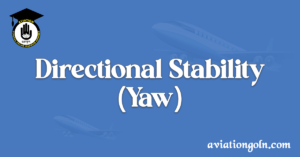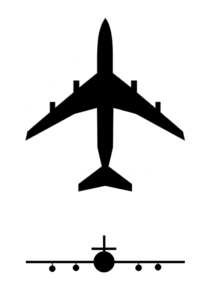When discussing the dynamic and complex world of aircraft stability and control, one of the essential areas of focus is directional stability. This is the stability of an aircraft about its vertical axis, commonly referred to as yaw motion. Understanding this is vital for both the design and safe operation of any aircraft.
Directional Stability (Yaw): Principles of Stability and Control

1. Introduction to Directional Stability
An aircraft’s ability to restore itself to its original flight path after being disturbed by yawing moments is a measure of its directional stability. In simpler terms, when an aircraft’s nose moves left or right (yawing), how effectively it returns to its original forward-facing direction without the intervention of the pilot is its directional stability.

2. Basics of Yaw Motion
The yawing motion of an aircraft is a rotation about its vertical axis. The aircraft’s nose moves either to the left (port) or to the right (starboard). This motion is controlled by the rudder, a movable control surface located on the vertical stabilizer (or fin) at the tail of the aircraft.

3. Factors Influencing Directional Stability
A. Vertical Tail Fin:
The vertical tail fin provides the primary source of directional stability. When the aircraft yaws away from its flight path, the fin experiences an angle of attack. This creates an aerodynamic force that opposes the yaw, thereby stabilizing the aircraft.
B. Fuselage Design:
The fuselage, especially its rear portion, can also contribute to directional stability. An aircraft with a longer fuselage behind its center of gravity (CG) will generally have better directional stability.
C. Wing Sweep:
Swept-back wings can enhance directional stability. As the aircraft yaws, the swept wing’s side further from the oncoming flow sees an increased effective span, producing more lift than the other side, countering the yaw.
D. Propeller Effects:
In single-engine propeller-driven aircraft, the propeller’s swirling slipstream can interact with the vertical fin, affecting stability. Additionally, any engine failure can introduce yaw due to asymmetric thrust.
E. Dihedral Effect:
While dihedral is mainly associated with roll stability, it has an indirect effect on directional stability. When an aircraft yaws, one wing moves forward relative to the oncoming airflow, producing more lift than the other, which results in a rolling motion. If this rolling motion results in a sideslip that produces a correcting yaw moment (due to the vertical tail), it can enhance directional stability.

4. Weathercock Stability
An ideal aircraft behaves like a weathercock or a wind vane. When disturbed by a gust of wind, a weathercock will always align itself with the direction of the wind. This behavior is what aircraft designers aim for in terms of directional stability.

5. Dutch Roll
One of the interesting phenomena associated with yawing motion and stability is the Dutch Roll. It’s a combination of yawing and rolling oscillations, usually observed in swept-wing aircraft. If an aircraft has strong directional stability but weak lateral (rolling) stability, it might enter into a Dutch roll after a yawing disturbance. Addressing this requires a balanced approach to design for both directional and lateral stability.

6. Yaw Damper
To assist in maintaining directional stability and mitigate issues like Dutch roll, many aircraft, especially jets, come equipped with a yaw damper. This is an automatic system that senses yawing motions and makes corrective rudder inputs, often without the pilot’s knowledge. It’s especially helpful during turbulent conditions.

7. Importance of Directional Stability in Flight
Directional stability is a critical aspect of aircraft design and performance, ensuring that an aircraft maintains its desired flight path and resists external disturbances that might divert it from its intended direction. In essence, it enables an aircraft to automatically realign itself with the direction of the prevailing wind after being disturbed.
Without adequate directional stability, an aircraft might experience unwanted yawing motions or tendencies to oscillate, making control challenging and possibly leading to dangerous flight conditions. This inherent stability, often achieved through design elements like the vertical stabilizer or fin, enhances pilot control, reduces the workload in maintaining a straight flight path, and ensures safer and more efficient operations in varying atmospheric conditions.

8. Testing and Enhancing Directional Stability
During the design phase, aircraft undergo rigorous testing, both in wind tunnels and flight tests, to measure and refine their directional stability. Adjustments can be made in various ways:
A. Increasing the Size of the Vertical Stabilizer:
This is the most direct way of enhancing stability. A larger fin will produce a stronger restoring force during yawing disturbances.
B. Adjusting Fuselage Design:
As mentioned earlier, the fuselage shape and length can impact stability. Designers can adjust these factors to achieve the desired stability characteristics.
C. Wing Design Modifications:
Adjusting wing sweep or adding devices like winglets can also influence directional stability.

Directional stability, or yaw stability, is a cornerstone of aircraft design and operation. Achieving the right balance of stability ensures that the aircraft can recover from disturbances with minimal pilot intervention, enhancing both safety and comfort. Like other aspects of aviation, it’s a marriage of science, engineering, and art – understanding the principles, applying them in design, and refining based on real-world experience.
While this article has provided a comprehensive overview of directional stability, it’s worth noting that this is just one facet of the intricate world of aircraft stability and control. As with any complex machine, every component and design decision has consequences, and understanding these consequences is the key to creating aircraft that are both safe and efficient.
See more:
